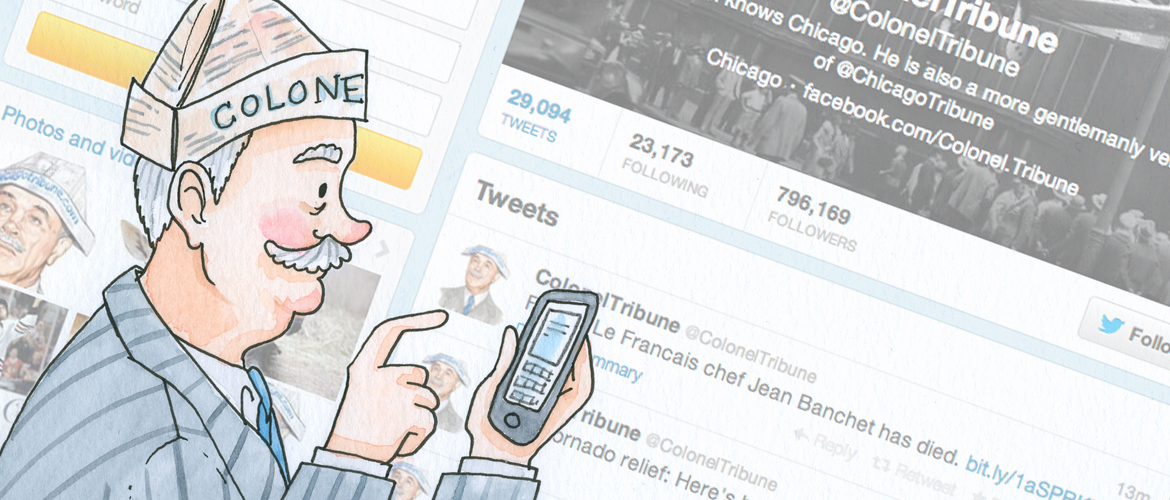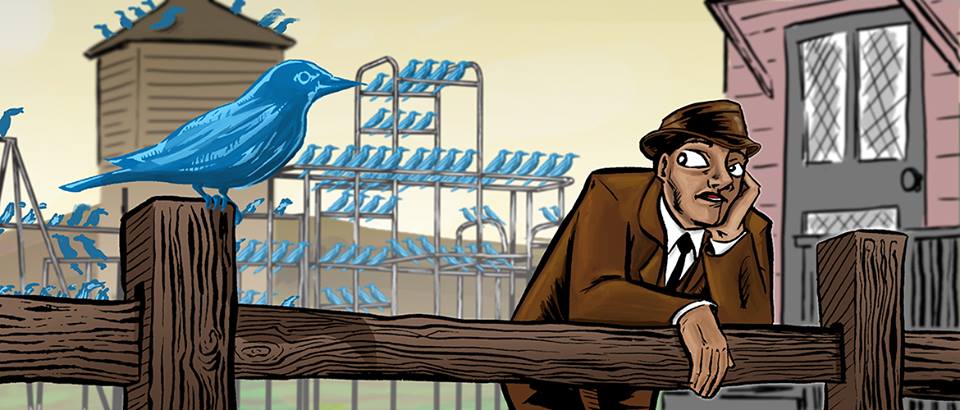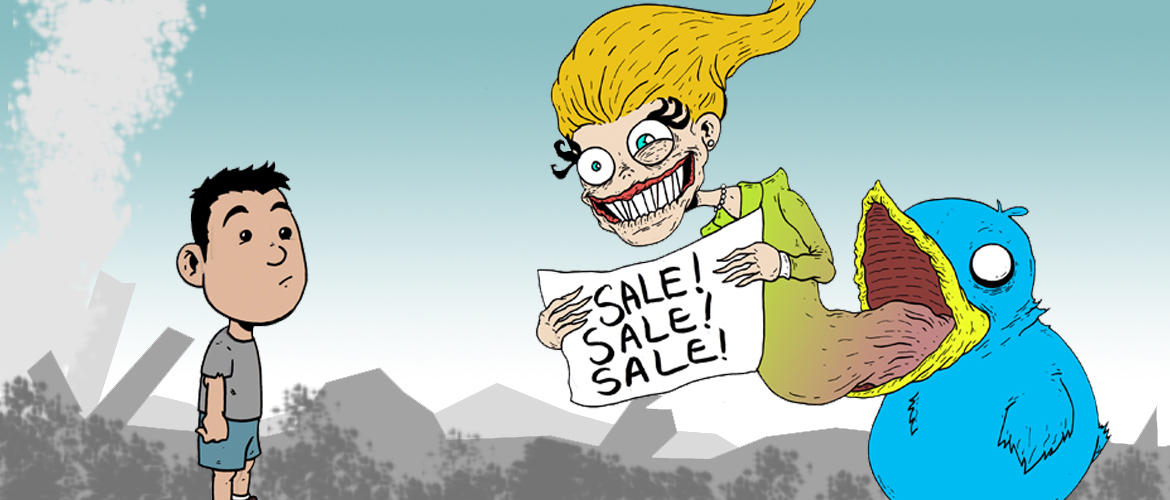Illustrated by David Flanagan
Updated and recycled from it’s original publish date in 2010.
Take a lesson from the Chicago Tribune on Twitter and increase followers by 2,298% just by being human.
I’ve taught social media to publishers across the country, and it breaks my heart when someone tells me during a workshop, “Oh, we’re just pushing feeds … The New York Times does it, and it works for them.” Or similarly, “We’ve just been automatically reposting blog content, and it seems to be working fine.”
Working fine? That’s called working “good enough.” People have RSS readers, so what incentive are you giving them to follow you on Twitter? How does this translate to your other marketing efforts? Are you always doing the bare minimum?
This is like comparing your personal Twitter account to Ashton Kutcher’s Twitter account. As a normal average human on this earth, I can’t do exactly as Ashton Kutcher does because I am not Ashton Kutcher. I haven’t been an Abercrombie model turned TV actor turned movie star. Therefore, what works for him isn’t going to get me 6 million followers.
The New York Times is the head honcho when it comes to social media popularity. A newspaper with 951,063 daily circulation has The New York Times Facebook page close to 800,000 fans and the @NYTimes Twitter account coming up on 3 million followers. The Wall Street Journal more than doubles them in terms of daily circulation, but are way behind in online presence.
 According to TweetStats, The New York Times:
According to TweetStats, The New York Times:
- posts 39.8 Tweets per day
- retweets at a rate of 0.18% – and only for other NYTimes accounts
- replies/mentions at a rate of 0.02% – again, only for NYTimes properties
In comparison, The Chicago Tribune is the ninth most circulated newspaper in the U.S., with 516,032 daily circulation. The Chicago Tribune Facebook page is nearing 20,000 fans and an official @ChicagoTribune Twitter account with just 35,000 followers.
Chicago Tribune on Twitter: How They Turned a Brand into a Personality
So, the ninth most circulated newspaper in the U.S. with an official Twitter account that ranks eighth came up with the brilliant idea of creating a separate, personal Twitter account for The Chicago Tribune.
While @ChicagoTribune is ranked eighth in terms of Twitter followers for national newspapers, they actually rank No. 2 with a more personal account called @ColonelTribune. The @ColonelTribune account is designed to serve the average news reader, and isn’t catering to the news junkie that subscribes to newspaper feeds as a replacement to their RSS feed.
The @ColonelTribune account hand-selects articles to tweet about so that they don’t overwhelm their readers, and every headline is rewritten in the form of an engaging discussion-starter.

Here’s the thing, I’m not even going to trash-talk the Chicago Tribune for their branded Twitter feed. Sure: They’re missing a bio; they’re not following anyone; and they’re relying on their brand to get Twitter followers. All forgiven.
Why? I’m not going to offer any type of criticism, because what they’ve done separately is brilliant.
For those who only want headlines, they’ve got @ChicagoTribune. There are more than 35K people on Twitter who are perfectly happy to use this feed in order to get their news. They don’t need anyone to reply to a question; they don’t need any kind of engagement – they simply want the news.
However, for those 845K people on Twitter who want a little personality with their news, they’ve created @ColonelTribune. This account is “the more gentlemanly version of @ChicagoTribune” and always rewrites headlines to be more interesting, @ replies to people, and is seen as “the face” of The Chicago Tribune, even if he is simply a mascot.
Ahead of the curve, the Chicago Tribune created “Colonel Tribune” as a face of the brand back in March of 2008 when they assembled a social media team to work on building their company image via networks like Facebook, YouTube, Flickr, and Twitter. They immediately saw an 8% increase in page views on top of the millions of page views they were already getting.
Daniel Honigman, former Social Media Strategist for the Tribune Media Group, told Mashable last year:
“Essentially, we wanted to find our audience regardless of the medium. The Colonel acts as a touch point for the Tribune and serves as our voice on the web. Thus, we needed a front man, which turned into Colonel Tribune. Who is kind of a goofy man about town. but is an actual person. He would even answer questions that you might have.”
Is @ChicagoTribune Dead on Twitter?
What I noticed while researching this article was that the @ChicagoTribune feed has been down for almost a month. This made me question whether they had abandoned the account in favor of the more popular account, or if the feed was simply broken and they hadn’t noticed yet.
So, I decided to take my question to @ColonelTribune. I did this for two reasons. First, I did it because I wanted to know if I would get a response or if the old man in a paper hat would shun me for asking such a silly question. Second, I did it because I wanted an answer and it it’s hard to get one through email.
To my surprise, @ColonelTribune answered me in less than two minutes.

When I asked Bill Adee, VP of Digital Development & Operations for the Tribune Media Group, about the stagnant @ChicagoTribune account, he confirmed that they hadn’t abandoned the account and that they “only recently regained control over it” and are “going to fix up the page and the feed soon.”
He also noted that they do in fact believe “the @ColonelTribune account is the important one for engaging with [their] audience and learning from it.”
Comparing Site Traffic Between the Big-Wigs
In general, site traffic for all of the large newspaper sites has seen a dive over the last year. Even the Wall Street Journal, which doubles The New York Times in daily circulation, is down 36% in terms of site traffic, going from almost 12 million to 7.5 million this year. That’s why a need for better social media has come up.

The New York Times isn’t much better—down 17% from last year. This is coming from almost 21 million unique visitors last year to a little more than 17 million this year.

The Chicago Tribune has seen the least decrease of the three, but is still down about 16%, coming from close to 3 million unique visitors per month down to 2.4 million. However, they did see a 15% hike between the months of May and June.

As you can see, all newspaper sites have taken a digger in terms of site traffic. However, smart newspapers like The Chicago Tribune believe in the power of social media. In fact, they’ve seen the benefits firsthand.
After all, the Colonel Tribune project started based on a surge in traffic that they initially got from Digg. A small local article got 16,000 page views on the day it was published and dropped down to 1,300 the next day. This is typical.
What wasn’t typical was the 43,300 page views they got 9 days later when it got picked up by Digg and drove more than 126,000 more unique views by the end of the month.
After this, they put together the small social media team I wrote about earlier, and have been putting their faith in social media ever since.
The Takeaway From This Case Study
Speaking in generalities, a newspaper doesn’t need to work hard at getting thousands of followers. When you’re the third most circulated newspaper in the U.S. like The New York Times, you don’t need to adhere to the rules of engagement that we hold other companies to. Would it be nice? Sure. Would it increase their followers even more? Probably. Will The New York Times survive social media without responding to @ replies and without retweeting other newspapers? Without a doubt.
Even though The Chicago Tribune is still considered high up on the totem pole of newspaper circulation (they’re #9), the company understands the importance of leveraging personality and charisma on social networks. So many large publications think that they are untouchable and that they don’t need social media to get by, while smaller publications think they can build their online brand by watching what the leaders are doing.
The big secret: Many newspaper publishers, especially the big ones, have no idea what they’re doing. Trust me, I’ve been to enough publishing conferences and networked at enough events to tell you that everyone in the industry is still watching what everyone else is doing. It’s like the blind leading the blind.
The lesson: Don’t copy your idols.
The solution is to close your eyes and ignore what everyone else is doing. You’re a consumer … what do YOU respond to? When The Chicago Tribune put together their new social media team back in 2008, they were literally starting from scratch, because nobody in the industry was leveraging the medium successfully yet.
Social media is your chance to stand out and create a unique online presence. By doing what everyone else is doing, you’re simply fading into the background.







